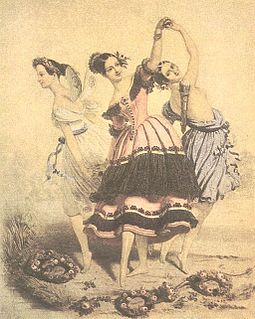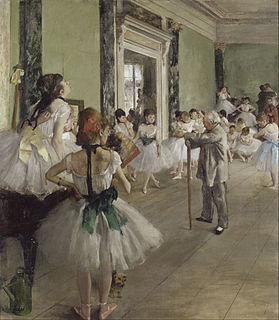External links
Le Groupe de la Place Royale fonds (R5793) at Library and Archives Canada
Le Groupe Dance Lab (formerly Le Groupe de la Place Royale) was a contemporary dance research centre formed in Montreal in 1966 as a dance company. It re-located to Ottawa in 1977 and changed its name and artistic mission in 1988. It closed its doors in 2009. The Dance Lab was founded by Jeanne Renaud and the main (and original) Artistic Director was Peter Boneham.
Le Groupe de la Place Royale fonds (R5793) at Library and Archives Canada

The Académie Royale de Peinture et de Sculpture was founded in 1648 in Paris, France. It was the premier art institution of France during the latter part of the Ancien Régime until it was abolished in 1793 during the French Revolution. It included most of the important painters and sculptors, maintained almost total control of teaching and exhibitions, and afforded its members preference in royal commissions.

The Paris Opera Ballet is a French ballet company that is an integral part of the Paris Opera. It is the oldest national ballet company, and many European and international ballet companies can trace their origins to it. It is still regarded as one of the four most prominent ballet companies in the world, together with the Royal Ballet in London, the Bolshoi Ballet in Moscow and the Mariinsky Ballet in Saint Petersburg.

The Romantic ballet is defined primarily by an era in ballet in which the ideas of Romanticism in art and literature influenced the creation of ballets. The era occurred during the early to mid 19th century primarily at the Théâtre de l'Académie Royale de Musique of the Paris Opera Ballet and Her Majesty's Theatre in London. It is typically considered to have begun with the 1827 début in Paris of the ballerina Marie Taglioni in the ballet La Sylphide, and to have reached its zenith with the premiere of the divertissement Pas de Quatre staged by the Ballet Master Jules Perrot in London in 1845. The Romantic ballet had no immediate end, but rather a slow decline. Arthur Saint-Léon's 1870 ballet Coppélia is considered to be the last work of the Romantic Ballet.

Rap Nigerien is a hip hop music style that first appeared in Niamey, Niger, at the end of 1998.
In the French courts during the 17th Century, ballet first begins to flourish with the help of several important men: King Louis XIV, Jean-Baptiste Lully, Pierre Beauchamps, and Molière. The combination of different talents and passions of these four men shaped ballet to what it is today.

A ballet master is an employee of a ballet company who is responsible for the level of competence of the dancers in their company. In modern times, ballet masters are generally charged with teaching the daily company ballet class and rehearsing the dancers for both new and established ballets in the company's repertoire. The artistic director of a ballet company, whether a male or female, may also be called its ballet master. Historic use of gender marking in job titles in ballet is being supplanted by gender-neutral language job titles regardless of an employee's gender.
Jean-Louis Morin was a Canadian choreographer and the principal dancer for the Martha Graham Dance Company.

The Académie Royale de Danse, founded by Letters Patent on the initiative of King Louis XIV of France in March 1661, was the first dance institution established in the Western world. As one of King Louis’ first official edicts after the death of royal adviser Jules Mazarin, the “Letters Patent of the King to Establish a Royal Academy of Dance in the City of Paris” represented a critical step towards the young King's wielding of consolidated personal power. Structurally, the Académie consisted of thirteen dancing masters selected by King Louis XIV for being the “most experienced in the Art [of dance].” This "experience" was determined by each dancer's history of success in previous royal productions of ballets de cour. Most famously, eight of the selected dancing masters performed with King Louis XIV during his portrayal of Apollo, the Sun King, in LeBallet de la nuit (1653). Although the object of the Académie was to reflect, analyze and normalize matters of dance, no document relating to its activity or to this theorization has survived. The Académie Royale de Musique, founded in 1669 as the Académie d'Opéra, was a closely related opera and ballet company, and although the two institutions never merged, members of the dance academy were also associated with the opera. Little by little, recruitment of dancers into the royal entourage gave way to recruitment into the ballet-corps of the Opéra. This slowly altered the Académie's profile, making it and its members more dedicated to dance training alone. By 1775, the Académie was nearing the end of its life. On joining the Académie, Jean-Georges Noverre, one of ballet d’action’s most influential choreographers, commented on its ineffectiveness in making meaningful contributions to the dance world. Along with many other royal institutions, the dance academy ceased to exist at the time of the overthrow of the monarchy in 1789, but the opera and ballet company survived and today is known as the Opéra National de Paris.

Jean-Marie Klinkenberg is a Belgian linguist and semiotician, professor at the State University of Liège, born in Verviers (Belgium) in 1944. Member of the interdisciplinary Groupe µ. President of the International Association for visual Semiotics.

The Socialists and affiliated group is a parliamentary group in the National Assembly including representatives of the Socialist Party (PS).
Los Angeles Ballet (LAB) is a classical ballet company based in Los Angeles. While rehearsals take place at the Los Angeles Ballet Center, the company tours venues across LA County, such as the Dolby Theatre and Royce Hall, during its performances. LAB typically hosts two classical ballets each season, with an additional Balanchine performance in the spring. The company was founded and is co-directed by husband-and-wife team Thordal Christensen and Colleen Neary. The company debuted December 2006 with an original performance of The Nutcracker.
The Imprimerie nationale is the official printing works of the French government, in succession to the Manufacture royale d'imprimerie founded by Cardinal Richelieu. Its Président-directeur général is Didier Trutt.

Paul-André Fortier is a Canadian choreographer and dancer living in Montreal. He is a recipient of the Governor General's Performing Arts Award for lifetime achievement.
L'Équipe, often called La Chaîne L'Équipe to distinguish it from its newspaper namesake, is a French sports television channel. It launched as a basic subscription channel in 1998, under the name L'Équipe TV. In late 2012, L'Équipe TV became L'Équipe 21 and started broadcasting in high definition on France's free digital terrestrial television. It was rebranded again as just L'Équipe in September 2016.
Vincent Warren, was a Canadian dance historian and lecturer. After a distinguished career as a ballet dancer and teacher, he became widely known and respected as a historian and archivist. He is celebrated as a leading figure in the dance world of Canada.
Martine Époque was a French-born Canadian dance educator and choreographer living in Quebec.
Jeanne Renaud is a Canadian dancer, choreographer and artistic director. She is considered to be one of the founders of modern dance in Quebec. Born in Montreal, Renaud studied music at the École de musique Vincent-d'Indy. She trained in classical ballet with Elizabeth Leese and in modern dance with Gérald Crevier in Montreal. She went on to study with Merce Cunningham, Hanya Holm and Mary Anthony in New York City. In 1948, she gave a recital with Françoise Sullivan in Montreal. She taught dance in Paris from 1949 to 1954. In 1952, she joined with Les Automatistes who had left Quebec for Paris to present a performance at the American Club there. From 1959 to 1965, she was associated with Françoise Riopelle at the École de Danse Moderne de Montréal as dancer, teacher and choreographer. In 1966, she founded Le Groupe de la Place Royale, the first official modern dance company in Quebec, with Peter Boneham; she was dancer, choreographer, artistic director and administrator for Le Groupe until 1972.
Peter Boneham is an American-born Canadian choreographer, dance educator and artistic director. To date, he has been the longest serving artistic director for a Canadian contemporary dance company.
Le Groupe des XV was a collective founded in 1946 by fifteen French humanist photographers who exhibited annually in Paris until 1957. Its objective was to have photography recognised as an art form in its own right, and to use it to preserve French photographic heritage.
Groupe Sogha is a Nigerien neo-traditional music group that combines traditional and modern instruments in its music. The word Sogha means “beauty” in the Zarma-Songhay language. The group is composed of ten members, five instrumentalists, three singers, and two dancers.